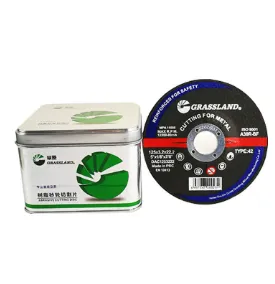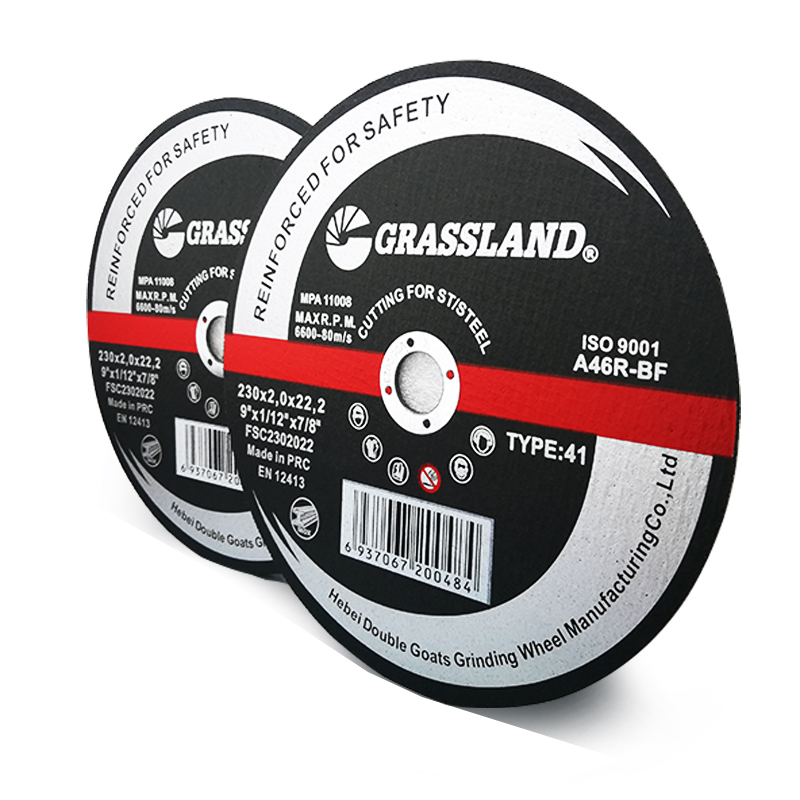When working with stainless steel, using the right stainless steel cutting disc is essential to ensure clean, precise cuts without compromising the material’s integrity. Stainless steel is a strong and durable metal that requires specialized cutting discs designed to handle its unique properties. Choosing the best stainless steel cutting disc can make a significant difference in performance, efficiency, and the final finish.

A high-quality stainless steel cutting disc is typically made from premium abrasives such as zirconia or ceramic, which provide long-lasting durability and precision cutting. These materials generate less heat, reducing the chances of discoloration or warping of the stainless steel.
The thickness of the stainless steel cutting disc also plays a crucial role in its performance. Thin discs, typically between 1.0mm to 1.6mm, are preferred for making clean and precise cuts, minimizing material loss and reducing burr formation. Thicker discs, while more durable, may not be as efficient when cutting thin stainless steel sheets.
Another important feature of a stainless steel cutting disc is its bonding agent. High-quality discs use resinoid bonds, which enhance cutting speed while maintaining safety and longevity. Some discs are also reinforced with fiberglass layers for additional strength, reducing the risk of breakage.
Selecting the right stainless steel cutting disc ensures that each cut is smooth, accurate, and free from unnecessary heat buildup. Whether used in industrial fabrication, automotive repair, or home DIY projects, investing in the best cutting disc enhances productivity and delivers professional results.
Angle Grinder Discs for Stainless Steel: Choosing the Best Option
Selecting the right angle grinder discs for stainless steel is essential for achieving clean and efficient cuts while preserving the material’s finish. Stainless steel is a highly durable metal that requires specialized discs to prevent overheating, excessive sparks, and unwanted surface damage.
One of the most commonly used angle grinder discs for stainless steel is the thin-cut disc. These discs are typically 1.0mm to 1.6mm thick and are designed to provide precise, burr-free cuts. Thin discs generate less friction, reducing heat buildup and preventing the stainless steel from discoloring.
Flap discs are another important angle grinder discs for stainless steel used for finishing and smoothing edges after cutting. These discs contain overlapping abrasive flaps that gradually wear down, ensuring a consistent and smooth finish. Flap discs are perfect for blending weld seams and polishing stainless steel surfaces.
For heavy-duty applications, fiber discs are a great choice of angle grinder discs for stainless steel. These discs use a backing plate with abrasive grains, offering aggressive material removal while minimizing heat generation. They are ideal for large-scale fabrication projects that require consistent grinding and smoothing.
Choosing the correct angle grinder discs for stainless steel depends on the specific job requirements. Whether cutting, grinding, or finishing, selecting the right disc ensures efficiency, durability, and a flawless final result.
Cutting Disc for Stainless: Maximizing Performance and Longevity
Using the right cutting disc for stainless is essential to achieve clean, accurate cuts while prolonging the life of the disc. Stainless steel is a tough material that requires cutting discs specifically engineered for its properties to prevent overheating, excessive wear, and rough edges.
The material composition of the cutting disc for stainless plays a crucial role in its performance. Zirconia and ceramic abrasive grains are commonly used due to their durability and efficiency. These abrasives generate less heat, reducing the risk of burning or discoloring the stainless steel surface.
Another important factor when selecting a cutting disc for stainless is its speed rating. A high-speed-rated disc ensures faster and more efficient cutting without compromising precision. Always check the RPM rating of the disc to match it with the angle grinder’s capabilities.
Bonding agents used in the cutting disc for stainless also impact its longevity. High-quality resinoid bonds allow for faster cuts while maintaining stability and minimizing disc wear. Reinforced discs with fiberglass layers provide added strength and reduce the chances of breakage.
Storage and handling also affect the lifespan of a cutting disc for stainless. Keeping discs in a dry and cool place prevents moisture damage, while proper mounting techniques ensure smooth and consistent performance.
Selecting the best cutting disc for stainless ensures efficiency, precision, and long-term durability. Whether for professional metal fabrication or personal DIY projects, investing in a high-quality cutting disc guarantees excellent results.
Essential Tips for Using a Stainless Steel Cutting Disc Safely
Using a stainless steel cutting disc requires proper handling techniques to ensure safety and efficiency. Stainless steel is a strong material, and improper use of cutting discs can result in accidents or subpar performance.
One of the most critical safety tips when using a stainless steel cutting disc is to always wear personal protective equipment (PPE). This includes safety glasses, gloves, and a face shield to protect against sparks and flying debris.
Ensuring that the stainless steel cutting disc is securely mounted on the angle grinder is another important step. Loose discs can cause excessive vibrations and lead to uneven cuts or even breakage. Always check that the disc is properly fastened before use.
Maintaining the correct angle while cutting is essential for achieving precise and clean cuts. The ideal cutting angle for a stainless steel cutting disc is around 15 to 30 degrees. This prevents excessive friction and reduces the chances of overheating.
Applying the right amount of pressure is crucial. Excessive force can wear out the stainless steel cutting disc quickly and cause unnecessary strain on the angle grinder. Let the disc do the work and apply steady, even pressure for the best results.
Finally, inspecting the stainless steel cutting disc before each use ensures that it is free from cracks or damage. Using a damaged disc increases the risk of breakage and can lead to serious accidents. Always replace worn-out discs with new ones for maximum safety and efficiency.
Stainless Steel Cutting Disc FAQs
What is the best cutting disc for stainless steel?
The best cutting disc for stainless is a thin, high-quality disc made from zirconia or ceramic abrasives. These materials generate less heat, reducing the risk of discoloration and providing precise, burr-free cuts.
Can I use a regular cutting disc for stainless steel?
No, using a regular cutting disc on stainless steel is not recommended. Standard discs are not designed to handle stainless steel’s hardness and can overheat, causing poor cuts and excessive wear. Always use a stainless steel cutting disc for optimal results.
How do I prevent overheating when cutting stainless steel?
To prevent overheating, use a thin stainless steel cutting disc, maintain a steady cutting speed, and avoid excessive pressure. Taking breaks between cuts and using cooling agents can also help reduce heat buildup.
What is the best thickness for an angle grinder disc for stainless steel?
The ideal thickness for angle grinder discs for stainless steel is between 1.0mm and 1.6mm. Thin discs provide clean, precise cuts with minimal material loss and heat buildup.
How long does a stainless steel cutting disc last?
The lifespan of a stainless steel cutting disc depends on its quality, cutting speed, and material thickness. High-quality zirconia or ceramic discs last longer, while excessive pressure and overheating can reduce their durability.
Post time:Apr. - 29 - 2025

















